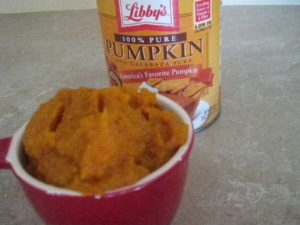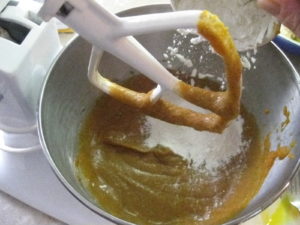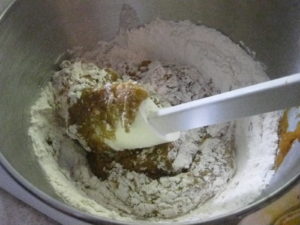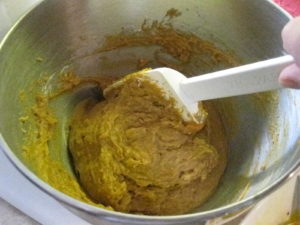Rumor has it that the first Whoopie Pie was made in the State of Maine in the 1920s. Amish women would bake these desserts and put them in farmers’ lunch-boxes. The farmers would excitedly shout “Whoopie!” when they discovered one of these sweet treats in their lunch box. Every time we visit Amish country, I find many different varieties of Whoopie Pies in the farmers markets—picking just one is always a hard decision! During our last visit, I was inspired by all the wonderfully delicious comfort foods I tasted and decided to bake up some Amish Whoopie Pies myself. This recipe has a great fall harvest flavor. It contains many of the spices found in pumpkin pie as well as pureed pumpkin, which is high in beta carotene–another great reason to make some for your kids. They will never even know (or care) that you sneaked in something healthy—they will be too busy shouting “Whoopie”!!!
INGREDIENTS:
- 1 1/2 sticks (6 ounces) unsalted butter, 1 stick melted, 1/2 stick softened
- 1 cup packed light brown sugar
- 2 large eggs, at room temperature, lightly beaten
- 1 cup canned pure pumpkin puree
- 1 tablespoon pumpkin pie spice (or combine your own mixture of cinnamon, cloves, nutmeg and ginger)
- 1 1/2 teaspoons pure vanilla extract
- 1 teaspoon baking powder
- 1 teaspoon baking soda
- 3/4 teaspoon plus 2 pinches salt
- 1-2/3 cups flour (use unbleached white flour–or consider mixing white and wheat flour together to increase the nutritional value)
- 4 ounces cream cheese, chilled
- 1 cup confectioners’ sugar ***(I used only 1/2 cup confectioners sugar and it tasted great—leave out the full cup if possible–or consider substituting another sweetener such as agave or brown rice syrup)
Directions:
- Preheat the oven to 350°. Line two baking sheets with parchment paper.
- In a large bowl, whisk together the melted butter and brown sugar until smooth. Whisk in the eggs, pumpkin puree, pumpkin pie spice, 1 teaspoon vanilla, the baking powder, the baking soda and 3/4 teaspoon salt. Using a rubber spatula, fold in the flour.
Using an ice cream scoop or tablespoon, drop 12 generous mounds of batter, spaced evenly, onto each baking sheet. Bake until springy to the touch, about 10 minutes. Transfer to a rack to cool completely.
- Using an electric mixer, cream the softened butter with the cream cheese. Add the confectioners’ sugar and the remaining 2 pinches salt and 1/2 teaspoon vanilla; mix on low speed until blended, then beat on medium-high speed until fluffy, about 2 minutes.
- Spread the flat side of 12 cakes with the cream cheese frosting. Top each with another cake
SpeechSnacks for /w/:
Every year I have a few children in therapy, generally 3-4 year olds, who have some trouble with lip rounding for the sound /w/. This sound, according to most developmental charts, is mastered by 90% of children by age 3. One of the most common substitutions I have observed is a /v/ for /w/. After a few sessions of teaching them some fun oral motor exercises, they are usually on their way to improving their lip strengthening and placement. Here are a few things you can do at home:
- Practice blowing kisses—have them watch you first, then ask them to try it themselves.
- Try applying a tinted lip gloss (or lip stick if you wish for your little girls) to both lips. Ask your child to pucker her lips into a kissing posture onto a piece of clean white paper. After she “kisses” the paper, take a look at the formation of her lips on the paper. Make sure it looks like it is forming a rounded pucker imprint. You can do this as well and compare your imprint to your child’s.
- Blow Bubbles to teach lip rounding. Watch the shape of their lips when your child blows bubbles through a wand–be sure the lips are rounded. If your child is having difficulty doing this, try squeezing her cheeks forward to get their lips in the right position.
- The Straw Technique: Using a “fat” straw–(think McDonald’s) have them position their lips around it. This will help create good lip rounding.
- Have a cotton ball race: using a fat or wide-mouth straw, have them blow a cotton ball across a table. You can race each other with your own straw and cotton ball.
- A word about Whistles: I like to use whistles in speech therapy to address oral motor strengthening and development. In the case of the /w/ sound, whistles are good for developing lip musculature. In general, whistles are helpful in developing tongue, cheek, jaw and lip musculature and respiratory
control for speech and feeding skills. They also provide motor planning practice for speech sounds. For the /w/ sound, I choose whistles that have different diameters, to help facilitate proper lip positioning techniques that mimic the /w/. We practice sound patterns with the whistle during therapy while pressing our lips firmly around the whistle opening. I ask parents to practice this at home as well, usually in sets of 20 repetitions. It’s a fun way to work on strengthening the lips!
Practice saying the word “WHOOPIE” with your kiddos–it’s a fun and happy word to say and practice.
Recipe words that contain the /w/ sound : WHISK, BOWL, BAKING POWDER, FLOUR, BROWN SUGAR
Ask WHO, WHAT, WHEN WHERE, WHY questions during and after you make the recipe together. This will provide them with a good model as they watch you make the /w/ in words and sentences.
SpeechSnacks for /p/:
I have addressed the /p/ sound in the Portobello Pizza recipe. You can click on this link to read about the production of the /p/ sound.
The Whoopie Pie recipe had so many opportunities to practice the /p/ sound—here are a few:
- Practice the phrase PUMPKIN WHOOPIE PIE —it’s a bit of a challenge with lots of transitions between the /p/ and /w/ sound. It’s a good way to see if your child has awareness and control of transitioning the lips for these two sounds.
- Focus on target words: PUMPKIN, PUREE, TABLESPOON, SPICES, BAKING POWDER
- Describe a pumpkin. Talk about how different it looks when it has been pureed and canned.
- Cut out all the pictures in this recipe and have your child describe each picture and sequence them in the proper order.
BOOKS ABOUT PUMPKINS to focus on the /p/:
Too Many Pumpkins by Linda White
The Runaway Pumpkin by Kevin Lewis
Pumpkin, Pumpkin by Jeanne Titherington
Big Pumpkin by Erica Silverman
BOOKS with the /w/ sound:
Where the Wild Things Are by Maurice Sendak
My ‘w’ Sound Box by Jane Belk Moncure
Books for kids about the Amish:
Amish Cooking for Kids by Phyllis Pellman
Plain Pigs ABC’s—A day on Plain Pig’s Amish Farm by Phyllis Pellman
Amish House by Richard Ammon
Just Plain Fancy by Patricia Polacco
Just Like Mama by Beverley Lewis




















Leave a Reply